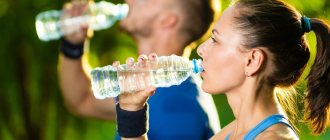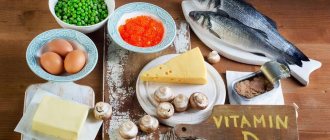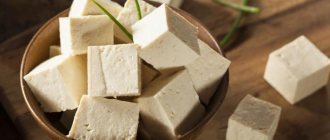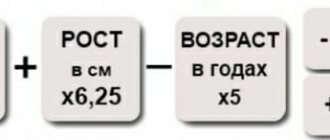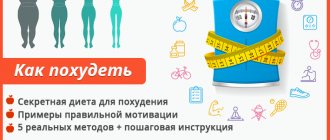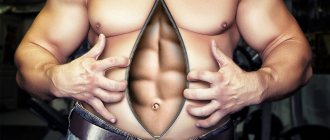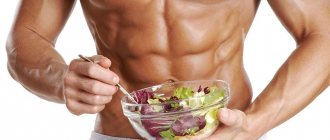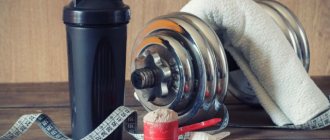Underweight is not initially a normal state of human health, but suggests that, due to certain factors, the human body does not receive or does not fully absorb the nutrients and energy it needs from the food it eats. It would seem that today the problem of obesity has become frighteningly urgent for humanity, but the number of people suffering from underweight is also steadily growing.
Basic principles of a diet for gaining muscle mass
Let's consider the basic rules that every athlete who wants to increase muscle mass must adhere to:
- Fractional meals. The number of meals per day should be at least 5. If you eat less often, but in large portions, then the body will not have time to cope with the incoming amount of food. What it is unable to process is stored as fat.
- Products must be high in calories. If caloric intake is low, then a person will have to eat more food (by volume), which can overload the digestive system. About 70% of all foods should be high in calories.
- Fast carbohydrates and fats should be limited in the menu. Otherwise, it will not be muscle mass that will increase, but the fat layer. As for fast carbohydrates (sweet fruits, flour products, sweets), they are absorbed almost instantly, so the body begins to store them “in reserve.” For the same reason, you should avoid fatty foods. First of all, this applies to sausage and lard.
- Following a sports diet in combination with regular training will allow you to build muscle mass. You need to eat food 2 hours before the start of your workout and an hour after its completion.
- Nutrition should be balanced:
- 10-20% comes from polyunsaturated fatty acids, which are the only sources of fat for the body;
- 50-60% comes from slow carbohydrates;
- 30-35% should be proteins.
- Be sure to drink a lot of water, at least 2.5 liters per day. Muscle strength with insufficient intake of water in the body decreases by 20%, which contributes to slow growth of muscle mass.
- You can't train without breaks. Muscles grow during the rest period between workouts. Stretching and adding muscle mass occurs within 3 to 7 days. During this time, loads should be interspersed with periods of rest. Naturally, one should not forget about the principles of sports nutrition. If a person has just started training, then the time interval between classes should be 72 hours, and for professional athletes 36 hours is enough. You should sleep at least 8 hours a day. If possible, you should avoid stress, since against the background of emotional turmoil, the level of cortisol in the body increases. This, in turn, promotes the growth of fat deposits and muscle burning. If you do not maintain the required rest intervals, your muscles will pump up rather than gain mass.
- Carbohydrates are burned by exercise. If you consume 20% more calories daily, this will allow you to build muscle mass. To prevent calories from going into fat, you should drink carbohydrate cocktails 2 hours before sports activities. They are also taken 1.5 hours after training.
- Cardio exercise is not a priority. One half-hour run per week is enough. This will help maintain cardiovascular health and increase endurance. If this condition is not met, the muscles begin to “burn.”
- Workouts that aim to gain muscle mass should last at least 50 minutes. Moreover, the number of repetitions of strength exercises is increased to 12 times, and the number of approaches is gradually increased to five.
- It should be borne in mind that giving up animal fats will lead to a decrease in testosterone levels in the blood. This negatively affects the formation of muscle mass, endurance decreases by 10%, and performance by 12%. Low testosterone levels help reduce the concentration of lactic acid during exercise, which entails a failure in metabolic processes, increased cholesterol levels in the blood, etc. Therefore, a person should receive at least 80 g of triglycerides per day. It is not recommended to exceed the norm of 100 g, otherwise they will begin to be deposited in fat. Therefore, you should not eat snacks, margarine, mayonnaise, chips, crackers, smoked products and spreads.
- At least 2 times every 30 days, you need to modify your sports program. New exercises are introduced into the training, the number of repetitions is increased or decreased, etc.
Example of a nutrient intake program
The following nutrient program is provided as a sample and is intended to be used with the muscle building diet suggested above. Modify it to suit your individual needs.
- 6:00 – Get up!
– 5 grams and 5 grams. - 6:30
– 1 gram of fish oil, multivitamin preparation. - Noon
– 1 gram of fish oil. - 14:30
– 40 grams of waxy maize (with casein protein shake). - 15:00 – 30 minutes before training
– 5 grams of BCAAs, 5 grams of nitric oxide donor. - 15:30 – Training!
- 16:30 – Post-workout complex:
5 grams of BCAA, 5 grams of glutamine, 5 grams of creatine, 40 g of waxy maize. - 17:30
– 1 gram of fish oil. - 20:30 — To the side!
5 grams glutamine, .
Your choice of beta-alanine.
Promising research has found a synergistic interaction between creatine and. Beta-alanine should be taken every 4 hours at a dosage of 750-800 mg. While taking beta-alanine, it is advisable to take additional supplements. To learn more about the interaction between beta-alanine and creatine, check out this resource.
It is important not to skip meals and not to fast for more than 3 hours. The ideal nutrition option for a man to gain muscle mass would be to eat according to the clock, so the body will quickly adapt to the system and itself will give a signal that it is time to eat.
On average, the body's adjustment to a new regime takes about 3-4 weeks.
Another secret to maintaining a routine is planning your meals in advance. At first you will have to weigh everything and keep a food diary, but over time this will no longer be necessary. There are special services for this on the Internet, or you can install applications on your phone.
For those who have not exercised before and have decided to gain weight, increasing physical activity within reasonable limits has a beneficial effect on appetite and nutrient absorption. Therefore, to accelerate weight gain, you need to use the muscles of the body. A set of exercises for both home and. And for those who are especially thin, it’s worth reading the article.
When starting the period of weight gain, a list of necessary products is compiled and purchased for the first week. It’s better to create a menu and prepare food for the whole day at once; this will help you distribute food correctly, so that you don’t add calories at the last moment with anything.
The time to gain weight takes different amounts of time for everyone, so you should clearly define the result. It is better to increase the calorie content and volume of food gradually, this way you can avoid discomfort and confidently move towards your goal. There is no need to rush in this matter, as they say, “the slower you go, the further you will go”
. Listen to your body and you will soon see positive changes.
Delicious dishes that can be prepared for future use.
Cold oatmeal, cutlets, meatballs, lasagna or stuffed peppers can be prepared for future use. The side dish “lives” in the refrigerator for a day, the sauce lasts for two days, eat the salad fresh, but you must cover it with a lid and under no circumstances leave a spoon inside.
It is better to buy bananas on the weekend and slightly unripe, so that they can be preserved until Friday and always be at hand. Don't be afraid of butter and full-fat milk, you're not a dry bikini, after all.
Daily norm of KBJU
The daily calorie intake is calculated using the Lyle MacDonald formula, or you can use a special nutrition calculator. The energy reserve coefficient, which is necessary for muscle development, is 1.2. Therefore, the resulting number is multiplied by this indicator.
The formula for calculating the daily calorie intake is: weight in kg * coefficient K, kcal/per kg of weight.
The K coefficient depends on the gender of the person, as well as on the speed at which metabolic processes occur in his body.
| Gender | Speed of metabolic processes | Coefficient K, kcal |
| Woman | Slowly | 31 |
| Woman | Fast | 33 |
| Man | Slowly | 33 |
| Man | Fast | 35 |
So, an example calculation:
Daily kilocalorie rate: 75 kg * 35 kcal = 2625 kcal
We multiply the resulting amount by the energy reserve coefficient: 2625 kcal * 1.2 = 3150 kcal.
Thus, it turns out that for a man weighing 75 kg, the daily calorie content should be equal to 3150 kcal. This will allow you to build 2 kg of muscle per month.
After determining the calorie content of the daily diet, let’s consider the correct ratio of nutritional supplements, which make up a sports nutrition complex for muscle development:
- Calculation of the daily protein requirement for men: 2 g per 1 kg of weight. If he weighs 75 kg, then the daily protein requirement is 150 g.
- The daily amount of fat depends on the age of the man:
- 130-160 g – up to 28 years;
- 100-150 g – up to 40 years;
- 70 g – after 40 years.
- The amount of complex carbohydrates is equal to 0.5 kg per day.
Permitted and prohibited products
Foods that should not be eaten during the diet:
- Fried meat, sausage, ham, frankfurters.
- Products that contain flavorings, preservatives, flavor enhancers and other chemicals.
- Butter, margarine, spread.
- Salo.
- Any confectionery and baked goods.
- Pickles, marinades, products that have undergone the smoking process.
Protein products
Protein foods that can be eaten during the diet:
- Dietary meats. This kind of meat is the best source of protein. Professional bodybuilders eat two servings of meat of at least 150 g each day.
- Chicken and turkey fillets can replace beef and lamb, as they contain a very small percentage of fat.
- Milk. Fat from milk is well absorbed by the body and is not stored “in reserve.”
- Fermented milk drinks.
- Eggs. Athletes seeking to build muscle mass eat at least 10 eggs daily. They refuse the yolk.
- Cottage cheese, which is a source of protein and beneficial microelements.
- Fatty fish, such as salmon. These products are sources of polyunsaturated fatty acids, which are necessary for the normal functioning of the body.
- Roasted and raw sunflower seeds.
- Buckwheat grain.
- Fresh and canned tuna.
- Lentils.
Carbohydrate foods
Products - sources of carbohydrates that are allowed to be eaten during the diet:
- Brown rice.
- Fruits other than grapes, bananas and pears.
- Garlic.
- Vegetables, including potatoes.
- Cereals.
- Bread.
- Greenery.
- Pasta made from flour obtained from durum wheat.
Fats
Products - sources of fats:
- Nuts: almonds, cashews, hazelnuts, walnuts and Brazil nuts.
- Fatty fish.
- Apple marshmallow.
Sources
- Dieta sportowca, Mgr Aleksandra Kopec
- Protein Requirements Are Elevated in Endurance Athletes after Exercise as Determined by the Indicator Amino Acid Oxidation Method; Hiroyuki Kato, Katsuya Suzuki, Makoto Bannai and Daniel R. Moore
- The myth of 1 g/lb: Optimal protein intake for bodybuilders
- Evidence-based recommendations for natural bodybuilding contest preparation: nutrition and supplementation; Eric R Helms, Alan A Aragon and Peter J Fitschen
Share
Rate
Proteins for weight gain - how much to eat for muscle growth
Rating: 5 (5)
Anatoly Kabanov
I’m gaining weight, looking after my health, writing about my experience. I don’t go to extremes, I check the information, including on myself. +8 kg in 2022.
Menu for a week of diet for gaining muscle mass
| First meal | Second meal | Third meal | Fourth meal | Fifth meal | Sixth meal | |
| 1 | Nuts, apple, oatmeal | Chicken meat with vegetables | Banana and cottage cheese | Rice with fish and vegetables | Vegetable salad, tuna | Fruit salad |
| 2 | Boiled buckwheat with milk and honey, orange | Pasta, baked veal, vegetables | Whole grain bread and kefir | Kiwi, cottage cheese with honey | Baked mackerel with vegetables | Yogurt, peanut butter, fresh berries |
| 3 | Banana, nuts, apple, oatmeal | Low-fat cut of veal, stewed vegetables | Omelet with a piece of black bread, apple | Fruit and milk smoothie | Boiled rice with chicken | Cottage cheese with jam |
| 4 | Rice cooked with milk, apple, nuts | Vegetable soup, veal | Whole grain bread, kefir | Fruit salad | Boiled turkey with baked potatoes | Vegetable salad |
| 5 | Stewed vegetables, omelet, chicken meat | Potatoes, boiled veal and banana | Apple, jam and cottage cheese | Fruit smoothie | Chicken meat, vegetables | Yogurt with strawberries and peanut butter |
| 6 | Banana, nuts, oatmeal | Chicken with stewed vegetables | Kefir and whole grain bread | Cottage cheese with honey and kiwi | Baked mackerel, buckwheat with vegetables | Fruit salad |
| 7 | Chicken, vegetables and omelette | Salad with vegetables, apple and veal | Cottage cheese, jam and banana | Fruit smoothie | Vegetables and rice, boiled chicken | Salad with vegetables |
Approximate menu for an athlete who seeks to gain muscle mass (options for 1 day):
| Breakfast | Snack before workout | Dinner | Snack after workout | Dinner |
| One banana, 2 slices of black bread, an omelette (either 1 whole egg or two whites). | 50 g kefir or cheese with 1% fat content, 2 slices of bread | ½ avocado, 0.1 kg turkey, 0.1 kg rice | 40 g nuts and gainer, 50 g dark chocolate | 0.1 kg broccoli, 0.2 kg chicken fillet, 0.1 kg rice |
| One pear, 150 g oatmeal, 30 g dark chocolate, cocoa | Low-fat cottage cheese – 0.2 kg, 4 teaspoons of honey and black tea | 0.2 l beef soup, 0.1 kg boiled buckwheat, 0.15 chicken fillet, 0.1 salad with vegetables, compote with dried fruits | 0.2 kg cottage cheese, 5 teaspoons honey, black tea | 5 egg whites, 0.15 kg vegetable salad, berry juice |
| One apple, 150 g buckwheat, milk | 150 g oatmeal, 3 teaspoons jam, grapefruit | 0.1 kg rice, 2 boiled eggs, a glass of milk | 2 bananas, 50 g chocolate | 0.2 kg fish, orange, green tea |
| 100 g of cottage cheese with 9% fat content and yogurt, 50 g of rolled oats | Apple, 40 g nuts, 80 g dried fruits | 0.1 kg mashed potatoes, 0.15 chicken fillet, orange juice and banana | 0.15 g oatmeal, milk | 0.15 kg cottage cheese, 4 teaspoons jam, 50 g nuts |
| 0.1 kg mashed potatoes, 0.15t kg veal, 0.1 kg stewed vegetables, one banana | ||||
| Banana, 1.5 scoops protein, 3 slices bread, 30 g peanuts | Two teaspoons of honey, green tea, 0.2 liters of vegetable soup, 0.2 kg of fish, 0.1 kg of rice, 0.2 kg of grapes | Smoothie with pineapple and chocolate, two slices of bread | 0.2 kg turkey, 0.1 kg buckwheat, 3 tablespoons vegetable oil, 0.1 kg cabbage and carrot salad | |
| One apple, 2 egg yolks, 4 egg whites, 50 g almonds | ||||
| 0.1 kg dried fruits, 40 g nuts |
Types of diets for mass gain
Depending on which foods a person prefers, diet options for weight gain will vary. There are three types: protein, carbohydrate and protein-carbohydrate. This also includes the energy and vegetarian diets.
Strict protein diet
Professional athletes adhere to a strict protein diet before upcoming competitions. It is aimed not only at gaining weight, but also at burning fat.
This diet involves a complete rejection of fatty foods and carbohydrates, but with the consumption of foods rich in protein. If a person’s priority is not cutting, but rather gaining weight, then such a diet will not suit him.
Protein-carbohydrate diet
A protein-carbohydrate diet is better suited for building muscle mass than others. The menu is designed in such a way that the body draws the energy it needs from carbohydrate foods and fat reserves, and takes building material for muscles from protein foods. Such diets do not involve strict prohibitions; they are suitable for everyone without exception.
Carbohydrate rotation diet
This diet option is gaining more and more popularity among people involved in sports every day.
It involves following 4 cycles:
- The menu for days 1 and 2 is low-carb. The amount of protein is 3-4 g/kg, carbohydrates - 1-1.5 g/kg.
- Menu 3 days: carbohydrates – 5-6 g/kg body weight, proteins – 1-1.5 g/kg body weight.
- Menu 4 days: proteins 2-2.5 g/kg, carbohydrates – 2-3 g/kg.
In the first days of the diet, the body uses up glycogen reserves and fat deposits. Muscles do not burn, since sufficient amounts of protein are supplied with food. When the second day comes to an end, the body begins to experience stress, as it receives a very limited amount of carbohydrates, so it begins to burn fat deposits more slowly, slowing down metabolic processes.
To speed up metabolism again, during the third day a person eats a sufficient amount of carbohydrate food. This misleads the body, and it continues to consume fat, accumulating glycogen.
The goal of the last day is to replenish glycogen reserves and prepare the body for a new diet cycle.
Vegetarian diet
Eating plant foods allows you to build muscle mass no worse than eating animal products. More protein-rich foods (nuts, grains, legumes, seeds) are introduced into the menu. The diet is supplemented with brewer's yeast and vitamin and mineral complexes. You need to eat often, but in small portions. To prepare dishes, you should use as many different products as possible. To prevent muscles from burning and gaining weight, you should eat food at least 8 times a day. In this case, 4 approaches to the table are basic, and another 4 approaches will be additional.
Energy diet
The Energy Diet from NL International is a nutrition system popular among athletes. The company produces products not only for gaining muscle mass, but also for losing weight.
Energydiet products are food supplements that must be consumed according to a specific schedule. It is compiled depending on the goal that a person pursues. It should be noted that the Energydiet course requires a very impressive financial investment. As for the effect, it can be achieved with the help of ordinary food products, but with a well-designed menu.
The main secret of success
The main secret to gaining weight is to consume more calories than the body burns in a day. If you get less energy from food than you expend in a day, you will not be able to gain a single kilogram of body weight.
It's also important to do strength training so that the calories are used to build muscle rather than gain fat. It doesn’t matter whether it’s training at home or visiting the gym, try to choose an effective complex.
Include these foods in your diet and stick to this diet for a long period of time.
4.3/5 — (18 votes)
Sports nutrition for a diet to gain muscle mass
Sports nutrition requires a person to strictly adhere to time limits and consume specific products, which is not always possible due to various circumstances. So, it is quite problematic for a working person to eat a variety of dishes 6 times a day. Therefore, athletes come to the aid of supplements that are designed taking into account their goals.
Such additives include:
- Gainers.
They are used to “get” the required amount of calories, as well as to ensure that protein is absorbed by the body more quickly. Gainers are drunk an hour before training so that the calories from them do not begin to be stored as fat. You can also use them after classes.
- Protein based powders.
These powders are protein sources that you mix into a mass gainer and drink before your workouts.
- Creatine
, which helps retain moisture in the muscles. Drink it before the upcoming workout, 40 minutes before it starts.
- Glutamine.
Glutamine is an amino acid found in muscles. The body produces it on its own, but athletes take it as a supplement.
Glutamine is taken before bed to achieve the following goals:
- Reduce protein costs;
- Reduce muscle pain;
- Activate immunity;
- Stimulate the production of growth hormone;
- Break down fats faster;
- Increase the amount of glycogen in the body;
- Prevent the toxic effects of ammonia on the body.
- BCAA group.
This abbreviation contains three amino acids: valine, leucine and isoleucine.
Goals that can be achieved by taking BCAAs:
- Reducing the harm that catabolism causes to the body (prevents the growth of muscle mass);
- These amino acids are essential for protein production;
- BCAAs are an additional source of energy for the body.
- Omega-3.
The purpose of taking polyunsaturated fatty acids:
If a person trains intensively, then he needs 4.5 times more glutamine. Indeed, during the growth of muscle mass in the blood, the level of glutamine drops by 18%.
An athlete consumes 5-7 g of the supplement per kg of weight per day. In adolescence, the dosage of 3-4 g per kg of weight should not be exceeded. There are also natural foods that contain glutamine - eggs, fish, beef, legumes, cabbage, parsley and spinach. You can also prepare yourself a sports cocktail, for which 10 g of the additive is diluted in 250 ml of water. Drink this drink in the morning on an empty stomach, after exercise and before a night's rest.
The more intensely a person trains, the more he needs these amino acids. If these reserves are not replenished, the body will begin to burn muscle tissue.
There are foods that are natural sources of BCAAs - peanuts, tuna, eggs, turkey and chicken, beef and salmon. If an athlete needs BCAAs, then the supplement is introduced into the diet before training and immediately after its completion. You can combine BCAA with gainer, protein and keratin.
- Improving brain function;
- Improved blood supply;
- Decreased appetite;
- Normalization of metabolic processes;
- Preventing muscle burning;
- Boosting the immune system;
- Prevention of heart and vascular diseases.
Foods that contain Omega-3 include: tuna, salmon, mackerel, halibut, herring, trout, flaxseed, oat germ, beans and walnuts. Daily intake of Omega-3 should be equal to 2-3 g per kg of weight. These healthy fats can also be taken in capsules as a food supplement, 2-6 g per day.
Find out more: Interesting Experiments and Research on the Amazing Benefits of Omega 3
